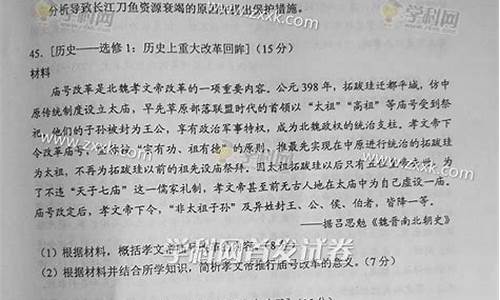您现在的位置是: 首页 > 教育研究 教育研究
2021高考非谓语动词学科网-2014高考非谓语
tamoadmin 2024-10-12 人已围观
简介1.怎样看这道题考的是非谓语动词还是动词的时态和语态2.高中英语非谓语动词讲解3.高考非谓语动词做题技巧4.关于非谓语动词 感觉非谓语动词好难呀 哪位高人能给我讲解讲解 高考唱考的非谓语动词的知识点。5.高考的语法题中如何区分位于动词和非谓语动词怎样看这道题考的是非谓语动词还是动词的时态和语态非谓语动词: 高考重点要求:1、掌握不定式、分词、动名词在句子中的作用2、区分不定式、分词作定语和状语的
1.怎样看这道题考的是非谓语动词还是动词的时态和语态
2.高中英语非谓语动词讲解
3.高考非谓语动词做题技巧
4.关于非谓语动词 感觉非谓语动词好难呀 哪位高人能给我讲解讲解 高考唱考的非谓语动词的知识点。
5.高考的语法题中如何区分位于动词和非谓语动词
怎样看这道题考的是非谓语动词还是动词的时态和语态

非谓语动词: 高考重点要求:
1、掌握不定式、分词、动名词在句子中的作用
2、区分不定式、分词作定语和状语的异同
3、掌握不定式、动名词作宾语,不定式和分词作宾补的惯用结构
4、注意非谓语动词与句子谓语动词的时间关系,以确定非谓语动词的时态形式
5、弄清非谓语动词与其逻辑主语的关系,以确定非谓语动词的语态形式
实战演练
一、复习时需注意的要点
1. 动词不定式一般式表示的动作可能与谓语动词的动作同时发生,也可能在其之后发生。
例如:I saw the young man enter the house.(同时发生)
I hope to go there next time.(之后发生)
2.不定式完成式表示不定式的动作在谓语动词之前发生。
例如:I’m sorry to have broken your glasses.
3.不定式进行式表示不定式的动作,与谓语动词同时发生。
例如:When he came in, I happened to be reading at the table.
4.不定式的被动式有两种形式:to be done表示将要被做,to have been done表示已被做。
例如:The new cinema to be put up next year will be very large.
The cinema is said to have been built last year.
5. 在表示情绪的动词,如like, love, hate, prefer等后,用动名词作宾语表示一般倾向,用不定式表示特定某事。但在would/should like/love/prefer后要用不定式
例如:I hate eating the same food every day.
Would you like to watch TV in the evening?
6. 在动词need, want, require后用动名词表示被动含义,相当于动词不定式的被动式;而用动词不定式的主动式表示主动含义。
例如:The house needs cleaning. = The house needs to be cleaned.
He needs to clean the house first.
7. 在介词后一般用动名词作宾语,但在少数介词,如but, except后用动词不定式作宾语,但要注意“to”的省略,如but前有“do”则省去“to”。
例如:I have done nothing but help him with his luggage.
I have no choice but to wait for him at the bus stop.
8. 分词的完成式一般不用来作定语,因此,要表示完成主动的意思常用定语从句。
例如:The accident which happened yesterday was very serious.
9. 如果分词短语的逻辑主语与句子不是相同的,则要用从句或分词独立主格结构来表示。
例如:Weather permitting, we will go to the Center Park.
10. 分词作状语时, 分词的逻辑主语要与句子的主语相一致。若它们之间的关系是主谓关系,用现在分词,而动宾关系则用过去分词。如果分词的动作先于谓语,分词要用完成时。
例如:Having finished his composition, he went home.
While looking through the paper, he found some errors.
二、历届高考试题分析
例1、The discovery of new evidence led to _________.
A. the thief having caught B. catch the thief
C. the thief being caught D. the thief to be caught
答案为C。
解析 lead to这个词组中to是介词,后面跟名词,于是B被排除,the thief是动名词逻辑上的主语,构成动名词的复合结构,与catch之间应是被动关系,故排除A。常见的带介词to的短语有:(get) be used to, look forward to,look up to, stick to, object to, be devoted to, pay attention to等。
例2、Though _______money, his parents managed to send him to university.
A. lacked B. lacking of C. lacking D. lacked in
答案为C。
解析 lack是及物动词,后接宾语money。his parents与lack是逻辑上的主谓关系,要用现在分词作状语。译文:虽然缺钱,他的父母亲还是设法让他上了大学。
例3、He got well-prepared for the job interview, for he couldn’t risk ____ the good opportunity.
A. to lose B. losing C. to be lost D. being lost
答案:B
解析 risk后面只能带动名词做宾语,含义为“冒……之险”。
例4、 _____ to sunlight for too much time will do harm to one's skin.
A. Exposed B. Having exposed C. Being exposed D. After being exposed
答案为C。
解析 在非谓语动词中,用动名词或不定式来作主语,而分词和介词短语不能作主语,因此A、D被排除。在这个句子中,will do是谓语,缺少主语,要用动名词作主语。expose与one's skin是动宾关系,所以要用动名词的被动式being exposed。译文:在阳光下晒太长时间对人的皮肤有坏处。
例5、____ into use in April 2000, the hotline was meant for residents reporting water and heating supply breakdowns.
A. Put B. Putting C. Having put D. Being put
答案:A
解析 put sth. into use “让……投入使用”。显然,put 和句子主语the hotline 构成被动关系,所以用表示被动的过去分词。
例6、It was unbelievable that the fans waited outside the gym for three hours just ____ a look at the sports stars.
A. had B. having C. to have D. have
答案:C
解析 动词不定式充当目的状语。
例7、With a lot of difficult problems _______, the newly-elected president is having a hard time.
A. settled B. settling C. to settle D. being settled
答案为C
解析动词不定式to settle作为difficult problems的定语表示现在或将来要解决的难题;过去分词settle作定语表示已经解决的难题,现在分词的被动式being settled作定语表示正在解决的难题。
例8、More and more people are signing up for Yoga classes nowadays, ____ advantage of the health and relaxation benefits.
A. taking B. taken C. having taken D. having been taken
答案:A
解析 take advantage of (利用)和句子主语More and more people 构成主动关系,且和句子谓语sign up for (报名参加)同时发生,所以选择A。
例9、 Sandy could do nothing but ________ to his teacher that he was wrong.
A. admit B. admitted C. admitting D. to admit
答案为A。
解析 该句中的but是介词,后接动词不定式。当谓语动词是do,does或did时,后接不带to的不定式;是其他动词时,后接带to的不定式。该句的谓语是could do nothing,要填动词原形admit。译文:山德不得不向老师承认自己错了。
例10、 He sent me an e-mail, ________ to get further information.
A. hoped B. hoping C. to hope D. hope
答案为B。
解析 现在分词hoping表示与send me an e-mail同时发生的动作。一些考生认为应该填不定式作目的状语。不定式作目的状语时,句子的正确形式是:He sent me an e-mail to get further information.不需要hope一词,如果要选择“hoped”时,句子的正确形式是:He sent me an e-mail and hoped to get further information。“hope”和“sent”作并列谓语。
动词时态和语态
高考重点要求:
1、通过上下文或所设定的语境,正确判断和运用各种时态
2、在书面表达中能根据动作发生的时间关系,正确使用动词时态
3、根据主语与谓语的逻辑关系,正确判断和运用主动语态和被动语态
历届高考试题分析
例1、More than a dozen students in that school ____ abroad to study medicine last year.
A. sent B. were sent C. had sent D. had been sent
答案:B
解析 be sent abroad 被派往国外。
例2、By the end of last year, another new gymnasium_________ in Beijing.
A. would be completed B. was being completed
C. has been completed D. had been completed
答案为D。
解析如:by意为“到……为止”。by后加过去时间,主句用过去完成时,如by后加现在时间,用现在完成时,如by后加将来时,主句要用将来完成时。by the end of last year常与过去完成时连用。表示到过去某个时候前已完成的动作。
例3、When and where to go for the on-salary-holiday_________ yet.
A. are not decided B. have not been decided
C. is not being decided D. has not been decided
答案为D。
解析 根据副词yet可确定用现在完成时,可排除A、C;不定式,动名词及从句作主语,谓语动词按单数处理,when and where to do sth.表示单数,要用has not been decided。
例4、He will have learned English for eight years by the time he _______from the university next year.
A. will graduate B. will have graduated
C. graduates D. is to graduate
答案为C。
解析 “by the time”后接定语从句,省略了关系副词when。在这种定语从句中要用一般现在时表示将来。译文:到明年他毕业之前,已经学了八年英语。
例5、Rainforests _______and burned at such a speed that they will disappear from the earth in the near future.
A. cut B. are cut C. are being cut D. had been cut
答案为C。
解析 这句话的意思是“雨林正在以那么快的速度被砍伐和烧掉以至于在不久的将来它们将会消失。”从句子的语境they will disappear from the earth in the near future可以判断,要用被动语态的现在进行时。表示现在正在发生的事对将来可能造成的影响。
例6、How I wish every family _______ a large house with a beautiful garden!
A. has B. had C. will have D. had had
答案为B。
解析 wish后接从句常用虚拟语气,表示这只是说话人的一种愿望。具体用法:如果从句中动作与现在事实相反应用过去式,与将来事实相反用would/could+动词原形;与过去事实相反用过去完成式或would/could+have done。译文:我多么希望每个家庭都住上带有漂亮花园的大房子。
例7、The new suspension bridge ________ by the end of last month.
A. has been designed B. had been designed
C. was designed D. would be designed
答案为B。
解析 在含有by引导的表示过去意义的时间状语的句子中,谓语动词要用过去完成时。译文:到上月为止已完成了吊桥设计。
例8、—How are you today?
—Oh , I__________ as ill as I do now for a very long time.
A.didn't feel B.wasn't feeling C.don't feel D.haven't felt
答案为D。
解析 现在完成时表示从过去的某个时候开始一直延续到现在的动作或状态。从句子的意思可知,从过去某个时候开始,已经病了很长时间了。
例9、—Hey, look where you are going!
—Oh, I'm terribly sorry. ________.
A. I'm not noticing B. I wasn't noticing
C. I haven't noticed D. I don't notice
答案为B。
解析 表示刚才没有注意到,要用过去进行时。一般现在时表示经常性的动作;现在完成时表示过去所做的事对现在造成的影响或从过去某个时候一直延续到现在的动作,即现在也没有注意到;现在进行时表示现在正在进行的动作,这三个时态显然不符合句意。
例10、A new cinema _______here. They hope to finish it next month.
A. will be built B. is built C. has been built D. is being built
答案为D。
解析 根据They hope to finish it next month.说明**院还在建设之中,所以从时态上讲是进行时;另外从语态上讲为被动语态。
动词时态和语态做题技巧如下:
1. 根据题干中的时间标志词选择时态
动词时态须与句中时间状语一致。高考题常在题干中加入具体情景,以测试考生对动词时态知识的实际运用能力。因此敏锐捕捉时间标志词,并结合具体的语境,选择出正确的动词时态。
2. 根据主从句时态呼应的原则选择时态
近年来的高考试题一般不再单纯考查主从句的时态呼应,而是将其放在真实的并且符合实际的语境中进行考查,也会结合强调结构等其它语法现象进行考查。 考生在根据时态呼应原则解题时,要把握好以下几点:
①在时间、条件等状语从句中,用一般现在时态表示一般将来时态,一般过去时态表示过去将来时态,用现在完成时态表示将来完成时态。
② 正确认定主句动词及从句动词两个动作发生的时间,并认真体会命题者所给出的语境。
③ 解答宾语从句与主句时态呼应题时,考生应熟知以下规则: 如果主句动词为现在时态,则从句动词可根据需要使用任何时态,如果主句动词为过去时态,则从句动词须用合适的过去的某种时态(表示客观真理时使用一般现在时态)。
3. 根据具体的语言环境选择时态
近年来高考试题对时态考查的要求越来越高,大部分试题趋向情境化、实际化。考生要捕捉信息,理解情境,综合运用,灵活答题。
高中英语非谓语动词讲解
一、非谓语动词种类及句法功能
(一)概述:
在英语中,不作句子谓语,而具有除谓语外其他语法功能的动词,叫做非谓语动词。非谓语动词有动词不定式(the Infinitive);动名词(the Gerund);现在分词(the Present Participle);过去分词(the Past Participle)。
1.非谓语动词与谓语动词的相同点有:
(1)如果是及物动词都可与宾语连用,例如:
They built a garden.
They suggested building a garden.
(2)都可以被状语修饰:
The suit fits him very well.
The suit used to fit him very well.
(3)都有主动与被动, “体”式(一般式;进行式;完成式)的变化。例如:
He was punished by his parents.(谓语动词被动语态)
He avoided being punished by his parents.(动名词的被动式)
We have written the composition.(谓语动词的完成时)
Having written the composition, we handed it in.(现在分词的完成式)
(4)都可以有逻辑主语
They started the work at once.(谓语动词的逻辑主语)
The boss ordered them to start the work.(动词不定式的逻辑主语)
We are League members.(谓语动词的主语)
We being League member, the work was well done.
(现在分词的逻辑主语)
2、非谓语动词与谓语动词的不同点有:
(1)非谓语动词可以有名词作用(如动词不定式和动名词),在句中做主语、宾语、表语。
(2)非谓语动词可以有形容词作用(如动词不定式和分词),在句中做定语、表语或宾语补足语。
(3)非谓语动词可以有副词作用(如动词不定式和分词),在句中作状语。
(二)非谓语动词的句法功能:
二、非谓语动词用法:
(一)动词不定式:(to)+do,具有名词、形容词、副词的特征。
1.不定式的形式:(以动词write为例)
否定式:not + (to) do
(1)一般式:不定式的一般式所表示的动作与谓语动词动作同时发生或发生在谓语动词动作之后,
例如:
I'm glad to meet you.
He seems to know a lot.
We plan to pay a visit.
He wants to be an artist.
The patient asked to be operated on at once.
The teacher ordered the work to be done.
(2)进行式:不定式的进行式所表示的动作与谓语动词动作同时发生,例如:
The boy pretended to be working hard.
He seems to be reading in his room.
(3)完成式:不定式的完成式表示的动作发生在谓语动词动作之前,例如:
I regretted to have told a lie.
I happened to have seen the film.
He is pleased to have met his friend.
2.不定式的句法功能:
(1)作主语:
To finish the work in ten minutes is very hard.
To lose your heart means failure.
动词不定式短语作主语时,常用it作形式主语,例如上面两句可用如下形式:
It is very hard to finish the work in ten minutes.
It means failure to lose your heart.
(2)作表语:
Her job is to clean the hall.
He appears to have caught a cold.
(3)作宾语:
常与不定式做宾语连用的动词有:want, hope, wish, offer, fail, plan, learn, pretend, refuse, manage, help, agree, promise, prefer, 如果不定式(宾语)后面有宾语补足语,则用it作形式宾语,真正的宾语(不
定式)后置,放在宾语补足语后面,例如:
Marx found it important to study the situation in Russia.
动词不定式也可充当介词宾语,如:
I have no choice but to stay here.
He did nothing last Sunday but repair his bike.
动词不定式前有时可与疑问词连用,如:
He gave us some advice on how to learn English.
(4)作宾语补足语:
在复合宾语中,动词不定式可充当宾语补足语,如下动词常跟这种复合宾语:want, wish, ask, tell, order, beg, permit, help, advise, persuade, allow, prepare, cause, force, call on, wait for, invite.
此外,介词有时也与这种复合宾语连用,如:
With a lot of work to do, he didn't go to the cinema.
有些动词如make, let, see, watch, hear, feel, have等与不带有to的不定式连用,但改为被动语态时,不定式要加to, 如:
I saw him cross the road.
He was seen to cross the road.
(5)作定语:
动词不定式作定语,放在所修饰的名词或代词后。与所修饰名词有如下关系:
①动宾关系:
I have a meeting to attend.
注意:不定式为不及物动词时,所修饰的名词如果是地点、工具等,应有必要的介词,如:
He found a good house to live in.
The child has nothing to worry about.
What did you open it with?
如果不定式修饰time, place, way,可以省略介词:
He has no place to live.
This is the best way to work out this problem.
如果不定式所修饰名词是不定式动作承受者,不定式可用主动式也可用被动式:
Have you got anything to send?
Have you got anything to be sent?
②说明所修饰名词的内容:
We have made a plan to finish the work.
③被修饰名词是不定式逻辑主语:
He is the first to get here.
(6)作状语:
①表目的:
He worked day and night to get the money.
She sold her hair to buy the watch chain.
注意不定式放句首时,逻辑主语与句子主语要一致:
wrong:To save money, every means has been tried.
right:To save money, he has tried every means.
wrong:To learn English well, a dictionary is needed.
right:To learn English well, he needs a dictionary.
②表结果:
He arrived late to find the train gone.
常用only放在不定式前表示强调:
I visited him only to find him out.
③表原因:
They were very sad to hear the news.
④表程度:
It's too dark for us to see anything.
The question is simple for him to answer.
(7)作独立成分:
To tell you the truth, I don't like the way he talked.
(8)不定式的省略:保留to省略do动词。
If you don't want to do it, you don't need to.
(9)不定式的并列:第二个不定式可省略to。
He wished to study medicine and become a doctor.
(二)动名词:
动名词既具有动词的一些特征,又具有名词的句法功能。
1.动名词的形式:
否定式:not + 动名词
(1)一般式:
Seeing is believing. 眼见为实。
(2)被动式:
He came to the party without being invited.他未被邀请就来到了晚会。
(3)完成式:
We remembered having seen the film. 我们记得看过这部**。
(4)完成被动式:
He forgot having been taken to Guangzhou when he was five years old.
他忘记五岁时曾被带到广州去过。
(5)否定式:not + 动名词
I regret not following his advice. 我后悔没听他的劝告。
(6)复合结构:物主代词(或名词所有格)+ 动名词
He suggested our trying it once again. 他建议我们再试一次。
His not knowing English troubled him a lot.
他不懂英语给他带来许多麻烦。
2.动名词的句法功能:
(1)作主语:
Reading aloud is very helpful. 朗读是很有好处的。
Collecting stamps is interesting. 集邮很有趣。
当动名词短语作主语时常用it作形式主语。
It's no use quarrelling.争吵是没用的。
(2)作表语:
In the ant city, the queen's job is laying eggs.
在蚂蚁王国,蚁后的工作是产卵。
(3)作宾语:
They haven't finished building the dam. 他们还没有建好大坝。
We have to prevent the air from being polluted.
我们必须阻止空气被污染。
注意动名词既可作动词宾语也可作介词宾语,如上面两个例句。此外,动名词作宾语时,若跟有宾语补足语,则常用形式宾语it,例如:
We found it no good making fun of others. 我们发现取笑他人不好。
要记住如下动词及短语只跟动名词作宾语:
enjoy, finish, suggest, avoid(避免), excuse ,delay, imagine, keep, miss, consider, admit(承认),deny(否认), mind, permit, forbid, practise, risk(冒险), appreciate(感激), be busy, be worth, feel like, can't stand, can't help(情不自禁地), think of, dream of, be fond of, prevent…(from),keep …from, stop…(from),protect…from, set about, be engaged in, spend…(in), succeed in, be used to, look forward to, object to, pay attention to, insist on, feel like
(4)作定语:
He can't walk without a walking-stick. 他没有拐杖不能走路。
Is there a swimming pool in your school? 你们学校有游泳池吗?
(5)作同位语:
The cave, his hiding-place is secret. 那个山洞,他藏身的地方很秘密。
His habit, listening to the news on the radio remains unchanged.
他收听收音机新闻节目的习惯仍未改变。
(三)现在分词:
现在分词既具有动词的一些特征,又具有形容词和副词的句法功能。
1、现在分词的形式:
否定式:not + 现在分词
(1)现在分词的主动语态:现在分词主动语态的一般式表示与谓语动词所表示的动作同时发生,完成
式表示的动作在谓语动词所表示的动作之前发生,常作状语。例如:
They went to the park, singing and talking. 他们边唱边说向公园走去。
Having done his homework, he played basket-ball. 做完作业,他开始打篮球。
(2)现在分词的被动语态:一般式表示与谓语动词同时发生的被动的动作,完成式表示发生在谓语动
词之前的被动的动作。
The problem being discussed is very important. 正在被讨论的问题很重要。
Having been told many times, the naughty boy made the same mistake.
被告诉了好几遍,这个淘气的孩子又犯了同一个错误。
2.现在分词的句法功能:
(1)作定语:现在分词作定语,当分词单独做定语时,放在所修饰的名词前;如果是分词短语做定语
放在名词后。
In the following years he worked even harder.
在后来的几年中,他学习更努力了。
The man speaking to the teacher is our monitor's father.
正与老师谈话的那个人是我们班长的父亲。
现在分词作定语相当于一个定语从句的句法功能,如:in the following years也可用in the years that followed; the man speaking to the teacher可改为the man who is speaking to the teacher.
(2)现在分词作表语:
The film being shown in the cinema is exciting. 正在这家上演的**很棒。
The present situation is inspiring. 当前的形势鼓舞人心。
be + doing既可能表示现在进行时,也可能是现在分词做表语,它们的区别在于be + doing表示进行的动作是进行时,而表示特征时是系动词be与现在分词构成系表结构。
(3)作宾语补足语:
如下动词后可跟现在分词作宾语补足语:
see, watch, hear, feel, find, get, keep, notice, observe, listen to, look at, leave, catch等。例如:
Can you hear her singing the song in the next room? 你能听见她在隔壁唱歌吗?
He kept the car waiting at the gate. 他让小汽车在门口等着。
(4)现在分词作状语:
①作时间状语:
(While) Working in the factory, he was an advanced worker.
在工厂工作时,他是一名先进工人。
②作原因状语:
Being a League member, he is always helping others. 由于是共青团员,他经常帮助他人。
③作方式状语,表示伴随:
He stayed at home, cleaning and washing. 他呆在家里,又擦又洗。
④作条件状语:
(If) Playing all day, you will waste your valuable time.
要是整天玩,你就会浪费宝贵的时间。
⑤作结果状语:
He dropped the glass, breaking it into pieces. 他把杯子掉了,结果摔得粉碎。
⑥作目的状语:
He went swimming the other day. 几天前他去游泳了。
⑦作让步状语:
Though raining heavily, it cleared up very soon.
虽然雨下得很大,但不久天就晴了。
⑧与逻辑主语构成独立主格:
I waiting for the bus, a bird fell on my heard.
我等汽车时,一只鸟落到我头上。
All the tickets having been sold out, they went away disappointedly.
所有的票已经卖光了,他们失望地离开了。
Time permitting, we'll do another two exercises.
如果时间允许,我们将做另两个练习。
有时也可用with (without) +名词(代词宾格)+分词形式
With the lights burning, he fell asleep. 他点着灯睡着了。
⑨作独立成分:
udging from(by) his appearance, he must be an actor.
从外表看,他一定是个演员。
Generally speaking, girls are more careful. 一般说来,女孩子更细心。
(四)过去分词:
过去分词只有一种形式:规则动词由动词原形加词尾-ed构成。不规则动词的过去分词没有统一的规则要求,要一一记住。
过去分词的句法功能:
1.过去分词作定语:
Our class went on an organized trip last Monday. 上周一我们班开展了一次有组织的旅行。
Those elected as committee members will attend the meeting. 当选为委员的人将出席这次会。
注意当过去分词是单词时,一般用于名词前,如果是过去分词短语,就放在名词的后面。过去分词做定语相当于一个被动语态的定语从句。
2.过去分词作表语:
The window is broken. 窗户破了。
They were frightened at the sad sight. 他们对眼前悲惨的景象感到很害怕。
注意:be + 过去分词,如果表示状态是系表结构,如果表示被动的动作是被动语态。区别:
The window is broken.(系表)
The window was broken by the boy.(被动)
有些过去分词是不及物动词构成的,不表示被动,只表示完成。如:
boiled water(开水) fallen leaves(落叶)
newly arrived goods(新到的货) the risen sun(升起的太阳)
the changed world(变了的世界)
这类过去分词有:gone, come, fallen, risen, changed, arrived, returned, passed等。
3.过去分词作宾语补足语:
I heard the song sung several times last week.
上周我听见这首歌被唱了好几次。
有时过去分词做with短语中的宾语补足语:
With the work done, they went out to play. 工作做完了,他们出去玩去了。
4.过去分词作状语:
Praised by the neighbours, he became the pride of his parents.
受到邻居们的表扬,他成为父母的骄傲。(表示原因)
Once seen, it can never be forgotten.
一旦它被看见,人们就忘不了。(表示时间)
Given more time, I'll be able to do it better.
如果给予更多的时间,我能做得更好。(表示条件)
Though told of the danger, he still risked his life
高考非谓语动词做题技巧
非谓语动词的做题步骤
1、判定是否用非谓语形式。方法:看看句子中是否已有了谓语动词了。
2、找非谓语动词的逻辑主语。方法:非谓语动词的逻辑主语一般是句子的主语。
3、判断主被动关系。方法:非谓语动词与其逻辑主语的主动还是被动关系。
4、判断时间关系。方法:分析句子,看看非谓语动词所表示的动作发生在谓语动作之前、之后还是同时。之前常用 done; 之后常用to do; 同时常用doing。
关于非谓语动词 感觉非谓语动词好难呀 哪位高人能给我讲解讲解 高考唱考的非谓语动词的知识点。
理解非谓语动词,关键是掌握两个内容,
1,理解非谓语动词的语态——主动被动
2,理解非谓语动词的时态——过去,现在,将来
解题分为以下步骤。
第一步,判断非谓语动词及其附属成分(以下简称非谓语动词),在句子里作什么成分。进行该步骤的目的,是为了寻找非谓语动词的逻辑主语,以方便判断非谓语动词的语态是主动还是被动。
非谓语动词作定语,逻辑主语是先行词
非谓语动词作状语,逻辑主语是主句主语
非谓语动词作补语,逻辑主语是宾语
非谓语动词在独立主格中,有独立主语
非谓语动词作表语,逻辑主语是主句主语
非谓语动词的特殊结构,句子不声明逻辑主语,则需另行判断。
第二步,根据句意,理解非谓语动词和逻辑主语的关系,是主动还是被动。
第三步,结合主句的谓语动词,判断非谓语动词发生的时间,是在过去,将来,还是同时发生。
过去 同时 将来
主动 having done | doing | to do
被动 done | being done | to be done
除了特殊情况(通常发生在非谓语动词作定语的时候),以上判断方法可以解决9成以上的题目。
高考的语法题中如何区分位于动词和非谓语动词
这么说吧,动词的全称就是谓语动词。你问的实际上就是谓语动词和非谓语动词的区别。一个句子里只能出现一个动词,如果有两个,咱们就把其中一个变成非谓语,方法是加ed 或ing.被动是ed.主动是ing









